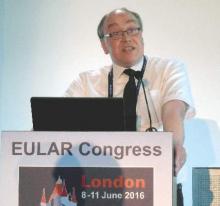LONDON – The new EULAR recommendations for fibromyalgia incorporate a decade’s worth of new evidence collected since the last edition appeared in 2008.
Although the 2016 recommendations do not reflect a novel understanding of the pathophysiology of fibromyalgia or a radically different approach to managing the disease, compared with those published in 2008, they differ vastly in the level and quality of supporting evidence behind them, said Dr. Gary J. Macfarlane, convener of the fibromyalgia recommendations panel and clinical professor of epidemiology at the University of Aberdeen, Scotland.
Dr. Macfarlane said that the past decade has seen “an explosion of evidence from randomized trials” around the management of fibromyalgia. “I think this will be one of the first EULAR guidelines in which all the recommendations are going to be based on systematic reviews or meta-analysis” – 107 altogether, he said in an interview.
Fibromyalgia – a heterogeneous pain condition that involves abnormal pain processing and can affect sleep, function, and quality of life – can be complex to diagnose and treat. Pain is a signature feature of fibromyalgia, but it is not the only treatment target: sleep, ability to function, and quality of life all are important, Dr. Macfarlane said.
The guidelines emphasize that optimal management of fibromyalgia requires not just a prompt diagnosis but “a comprehensive assessment of the patient’s ability to function and about the psychosocial context in which symptoms occur,” he said.
Patient education, including written information, is key and is the first step in management. Initial management should focus on nonpharmacologic interventions, specifically exercise. In patients for whom educational materials alone are insufficient to provide benefit, the next step is enrollment of the patient into a physical therapy program that involves an individualized program of graded physical exercise. Other nonpharmacologic interventions that can be introduced at this stage include hydrotherapy and acupuncture.
If there is insufficient response to these first two intervention steps, the next phase should start with a second round of patient assessment to develop an individualized intervention program. This involves characterizing the dominant features of the patient’s complaints into one of the three main categories: pain-related depression and anxiety, or behavior indicating abnormal coping strategies; severe pain, sleep disturbance, or both; or severe disability or sick leave, Dr. Macfarlane said at the European Congress of Rheumatology.
For patients in the first subgroup – pain-related depression and anxiety, or behavior indicating abnormal coping strategies – the intervention should consist of psychological therapies, primarily cognitive-behavioral therapy (CBT). For patients with more severe depression or anxiety, psychopharmacologic treatment is also an option.
For patients in the second subgroup – those with severe pain, sleep disturbance, or both – the main intervention is pharmacotherapy. For severe pain, this can involve duloxetine, pregabalin, or tramadol either alone or in combination with paracetamol (acetaminophen). For sleep disturbance, recommended drug interventions are low-dose amitriptyline, cyclobenzaprine, or pregabalin administered at bedtime.
For patients in the third subgroup – with severe disability or sick leave – the recommended intervention is a multimodal rehabilitation program.
“We made the decision to consider all therapies whether they were licensed in Europe or not because we felt that helps to contribute to the debate,” Dr. Macfarlane said. He also highlighted several interventions that have been proposed in the past, but which his working group refrained from recommending because of either lack of demonstrated effectiveness or the poor quality of the studies that appeared to document efficacy. These nonrecommended interventions are biofeedback, capsaicin, hypnotherapy, massage, S-adenosyl methinone or SAMe, and other complementary and alternative therapies.
Dr. Macfarlane noted that, despite a decade’s worth of findings, many questions still hover over the ideal management of fibromyalgia. Although the guidelines strongly promote exercise, “we still don’t have enough information about what specific type of exercise would be most beneficial.”
And while studies show overwhelmingly that CBT is effective, the size of the benefit is modest. Dr. Macfarlane said that it will be important to learn whether combined pharmacologic and nonpharmacologic approaches might be more effective from the get-go for certain patients – in contrast to the stepped approach outlined in the guidelines – and whether there is a way to identify patients for whom such interventions as CBT are most likely to be effective.
Another question still unanswered is whether fibromyalgia should remain primarily the domain of rheumatologists. While this was not a question addressed in the guidelines, the writing committee involved not only rheumatologists but also specialists in pain, internal medicine, occupational health, and nursing – underscoring the multidisciplinary direction that fibromyalgia treatment is taking.


